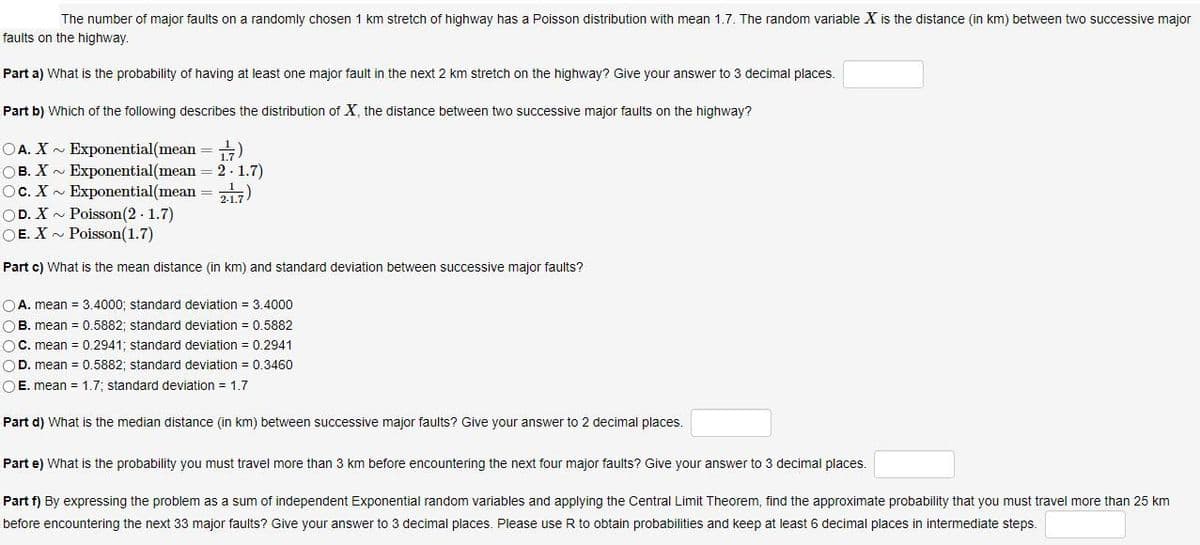The number of major faults on a randomly chosen 1 km stretch of highway has a Poisson distribution with mean 1.7. The random variable X is the distance (in km) between two successive major faults on the highway. Part a) What is the probability of having at least one major fault in the next 2 km stretch on the highway? Give your answer to 3 decimal places. Part b) Which of the following describes the distribution of X, the distance between two successive major faults on the highway? OA. X - Exponential(mean = ) OB. X Exponential(mean = 2 . 1.7) Oc. X - Exponential(mean = OD. X - Poisson(2 - 1.7) OE. X - Poisson(1.7) Part c) What is the mean distance (in km) and standard deviation between successive major faults? OA. mean = 3.4000; standard deviation = 3.4000 OB. mean = 0.5882; standard deviation = 0.5882 OC. mean = 0.2941; standard deviation = 0.2941 OD. mean = 0.5882; standard deviation = 0.3460 OE. mean = 1.7; standard deviation = 1.7
The number of major faults on a randomly chosen 1 km stretch of highway has a Poisson distribution with mean 1.7. The random variable X is the distance (in km) between two successive major faults on the highway. Part a) What is the probability of having at least one major fault in the next 2 km stretch on the highway? Give your answer to 3 decimal places. Part b) Which of the following describes the distribution of X, the distance between two successive major faults on the highway? OA. X - Exponential(mean = ) OB. X Exponential(mean = 2 . 1.7) Oc. X - Exponential(mean = OD. X - Poisson(2 - 1.7) OE. X - Poisson(1.7) Part c) What is the mean distance (in km) and standard deviation between successive major faults? OA. mean = 3.4000; standard deviation = 3.4000 OB. mean = 0.5882; standard deviation = 0.5882 OC. mean = 0.2941; standard deviation = 0.2941 OD. mean = 0.5882; standard deviation = 0.3460 OE. mean = 1.7; standard deviation = 1.7
MATLAB: An Introduction with Applications
6th Edition
ISBN:9781119256830
Author:Amos Gilat
Publisher:Amos Gilat
Chapter1: Starting With Matlab
Section: Chapter Questions
Problem 1P
Related questions
Question

Transcribed Image Text:The number of major faults on a randomly chosen 1 km stretch of highway has a Poisson distribution with mean 1.7. The random variable X is the distance (in km) between two successive major
faults on the highway.
Part a) What is the probability of having at least one major fault in the next 2 km stretch on the highway? Give your answer to 3 decimal places.
Part b) Which of the following describes the distribution of X, the distance between two successive major faults on the highway?
OA. X - Exponential(mean
OB. X - Exponential(mean = 2 - 1.7)
Oc. X - Exponential(mean = 217)
OD. X - Poisson(2 - 1.7)
OE. X- Poisson(1.7)
(푸
Part c) What is the mean distance (in km) and standard deviation between successive major faults?
OA. mean = 3.4000; standard deviation = 3.4000
OB. mean = 0.5882; standard deviation = 0.5882
OC. mean = 0.2941; standard deviation = 0.2941
OD. mean = 0.5882; standard deviation = 0.3460
O E. mean = 1.7; standard deviation = 1.7
Part d) What is the median distance (in km) between successive major faults? Give your answer to 2 decimal places.
Part e) What is the probability you must travel more than 3 km before encountering the next four major faults? Give your answer to 3 decimal places.
Part f) By expressing the problem as a sum of independent Exponential random variables and applying the Central Limit Theorem, find the approximate probability that you must travel more than 25 km
before encountering the next 33 major faults? Give your answer to 3 decimal places. Please use R to obtain probabilities and keep at least 6 decimal places in intermediate steps.
Expert Solution
This question has been solved!
Explore an expertly crafted, step-by-step solution for a thorough understanding of key concepts.
This is a popular solution!
Trending now
This is a popular solution!
Step by step
Solved in 4 steps with 10 images

Recommended textbooks for you

MATLAB: An Introduction with Applications
Statistics
ISBN:
9781119256830
Author:
Amos Gilat
Publisher:
John Wiley & Sons Inc

Probability and Statistics for Engineering and th…
Statistics
ISBN:
9781305251809
Author:
Jay L. Devore
Publisher:
Cengage Learning

Statistics for The Behavioral Sciences (MindTap C…
Statistics
ISBN:
9781305504912
Author:
Frederick J Gravetter, Larry B. Wallnau
Publisher:
Cengage Learning

MATLAB: An Introduction with Applications
Statistics
ISBN:
9781119256830
Author:
Amos Gilat
Publisher:
John Wiley & Sons Inc

Probability and Statistics for Engineering and th…
Statistics
ISBN:
9781305251809
Author:
Jay L. Devore
Publisher:
Cengage Learning

Statistics for The Behavioral Sciences (MindTap C…
Statistics
ISBN:
9781305504912
Author:
Frederick J Gravetter, Larry B. Wallnau
Publisher:
Cengage Learning

Elementary Statistics: Picturing the World (7th E…
Statistics
ISBN:
9780134683416
Author:
Ron Larson, Betsy Farber
Publisher:
PEARSON

The Basic Practice of Statistics
Statistics
ISBN:
9781319042578
Author:
David S. Moore, William I. Notz, Michael A. Fligner
Publisher:
W. H. Freeman

Introduction to the Practice of Statistics
Statistics
ISBN:
9781319013387
Author:
David S. Moore, George P. McCabe, Bruce A. Craig
Publisher:
W. H. Freeman